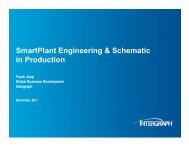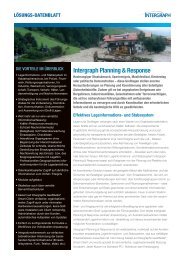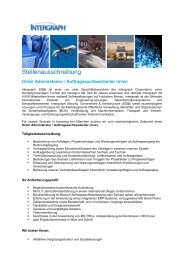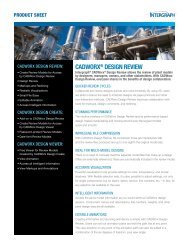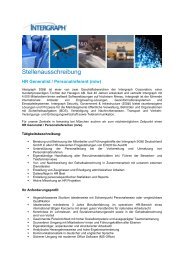Read the Nuclear Industry Spotlight - Intergraph
Read the Nuclear Industry Spotlight - Intergraph
Read the Nuclear Industry Spotlight - Intergraph
Create successful ePaper yourself
Turn your PDF publications into a flip-book with our unique Google optimized e-Paper software.
produced from fossil fuels and hydro power. Two<br />
large hydro projects are now under construction:<br />
one at Three Gorges and ano<strong>the</strong>r at Yellow River.<br />
<strong>Nuclear</strong> power must be added to <strong>the</strong> mix in order<br />
to meet demand, especially in <strong>the</strong> coastal regions<br />
far from <strong>the</strong> coalfields and in communities where<br />
<strong>the</strong> economy is rapidly developing.<br />
The China Atomic Energy Authority (CAEA) is<br />
responsible for planning and managing <strong>the</strong><br />
peaceful use of nuclear energy and promoting<br />
international cooperation. The CAEA reviews and<br />
approves feasibility studies for new plants, although<br />
<strong>the</strong> State Development and Planning Commission<br />
is ultimately responsible for final approval.<br />
According to Wu, nuclear energy is safe, clean,<br />
dependable and stable in cost. “As <strong>the</strong> country<br />
moves forward, nuclear power will become a<br />
vital source of electricity and will help reduce<br />
China’s dependence on coal, natural gas and<br />
oil to drive its rapid growth and modernization.<br />
Currently in China, <strong>the</strong> pressurized water<br />
reactor is <strong>the</strong> priority reactor. Plans call for <strong>the</strong><br />
high-temperature gas-cooled reactors (HTR) to<br />
be used to supplement current nuclear power<br />
generation. This will be a significant addition to<br />
<strong>the</strong> program since <strong>the</strong> HTR’s absolute quantity is<br />
remarkably large,” he said.<br />
Wu says China’s new HTR-10 (high- temperature<br />
10 megawatt reactor) will revolutionize nuclear<br />
power generation across <strong>the</strong> globe. The benefits<br />
of <strong>the</strong> pebble bed modular reactor are many, and<br />
with <strong>the</strong> opening of <strong>the</strong> new plant at Weihai<br />
in <strong>the</strong> Shandong Province in 2012, China will<br />
be <strong>the</strong> first country to commercially<br />
venture into this type of<br />
nuclear technology. The plant<br />
will be owned and operated by<br />
Huaneng Group, one of<br />
China’s largest independent<br />
utilities; China <strong>Nuclear</strong> Engineering<br />
and Construction<br />
Corporation, China’s construction<br />
company for <strong>the</strong> nuclear<br />
island; and Tsinghua University.<br />
The HTR-10 is powered by graphite<br />
balls about <strong>the</strong> size of standard<br />
billiards balls packed with tiny<br />
flecks of uranium, ra<strong>the</strong>r than<br />
with <strong>the</strong> conventional white-hot<br />
fuel rods used in existing nuclear reactors. Instead<br />
of super-heated water, <strong>the</strong> core is ba<strong>the</strong>d in inert<br />
helium, which can reach much higher temperatures<br />
without bursting pipes. No steam means no<br />
pressure dome is required to contain it in case of<br />
a leak.<br />
“First and foremost, this generator will be <strong>the</strong> safest<br />
nuclear power plant ever designed and built,”<br />
said Wu. “The major safety issue regarding nuclear<br />
reactors lies in how to cool <strong>the</strong>m efficiently, as <strong>the</strong>y<br />
continue to produce heat even after shutdown.<br />
Gas-cooled reactors, on <strong>the</strong> o<strong>the</strong>r hand, don’t need<br />
additional safety systems like water-cooled reactors<br />
do, and <strong>the</strong>y discharge surplus heat. Using <strong>the</strong><br />
existing operating HTR-10 research reactor at <strong>the</strong><br />
Institute of <strong>Nuclear</strong> and New Energy Technology<br />
of Tsinghua University in Beijing, we have already<br />
done what would be unthinkable in a conventional<br />
reactor – we switched off <strong>the</strong> helium coolant and<br />
successfully let <strong>the</strong> reactor cool down by itself,”<br />
said Wu.<br />
Second, <strong>the</strong> modular design enables <strong>the</strong> plant<br />
to be assembled much more quickly and costeffectively<br />
than traditional nuclear generators.<br />
The modules are manufactured from standardized<br />
components that can be mass-produced, shipped<br />
by road or rail and assembled relatively quickly. The<br />
new plants are smaller, and new modules can be<br />
added as needed. Multiple reactors can be linked<br />
around one or more turbines, all monitored from a<br />
single control room. In o<strong>the</strong>r words, <strong>the</strong> HTR-10’s<br />
design is tailor-made for <strong>the</strong> world’s fastest growing<br />
energy market.<br />
“Regions that are in <strong>the</strong> process of transforming<br />
from rural to industrial can start small, but add<br />
new modules as <strong>the</strong> area and its fuel demands<br />
grow,” said Wu. “We can provide <strong>the</strong>m with<br />
modules one at a time, if needed. This makes<br />
start-up costs affordable and <strong>the</strong> reactors will<br />
be cheaper to operate as <strong>the</strong>y grow, thanks to<br />
economies of scale in everything from staff to<br />
fuel supply,” he said.<br />
The byproduct of <strong>the</strong> nuclear reactor will be hydrogen,<br />
a clean fuel providing alternative, energy<br />
saving options that are less harmful to <strong>the</strong> environment.<br />
According to Wu, <strong>the</strong> HTR-10 is <strong>the</strong> only<br />
reactor which can provide a nuclear heat source to<br />
produce hydrogen.<br />
Construction of <strong>the</strong> $300 million plant should<br />
begin in 2009, with completion targeted for 2012.<br />
This streamlined construction timetable is also a<br />
first for <strong>the</strong> nuclear power industry, where designing<br />
and building generators usually take decades,<br />
ra<strong>the</strong>r than years.<br />
Not surprisingly, a number of countries are closely<br />
watching <strong>the</strong>se developments in China. Wu said,<br />
“Many of my colleagues around <strong>the</strong> world agree<br />
that high-temperature gas-cooled reactors using<br />
pebble fuel offer <strong>the</strong> most potential for commercially<br />
meeting <strong>the</strong> future environmentally friendly<br />
needs of global power generation.”<br />
Jana Miller is editorial director of Insight.<br />
www.chinergy.com.cn<br />
<strong>Nuclear</strong> <strong>Industry</strong><br />
Insight<br />
7




